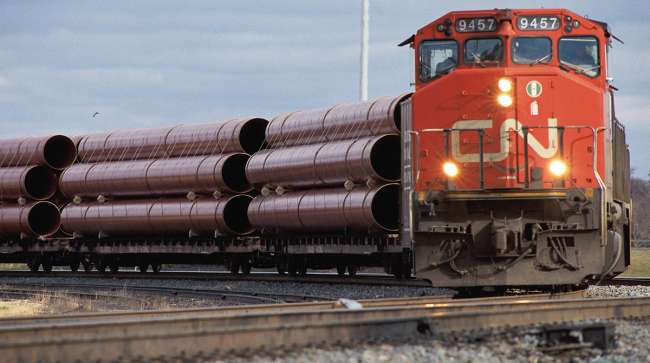Senior Reporter
Canadian National Reports Strong Q4 Earnings

[Stay on top of transportation news: Get TTNews in your inbox.]
Canadian National Railway reported healthy fourth-quarter income and revenue. The Class I railroad’s full-year results, however, declined as a result of soft second and third quarters due to the coronavirus pandemic’s impact on the North American economy.
Officials at the Montreal-based railway said Jan. 26 that its fourth-quarter net income rose 16.9% to C$1.02 billion, or $1.43 a share, compared with C$873 million (C$1.22) the same period a year ago.
Revenue increased 2% to C$3.65 billion compared with C$3.54 billion a year ago.

Ruest
Full-year income declined 15.5% to C$3.56 billion (C$5), compared with C$4.21 billion ( $5.83). Revenue dropped 7.4% to C$13.8 billion from C$14.9 billion a year ago.
“2020 was a year like no other, and thanks to our colleagues, who are essential workers, we got through it together and kept the economy moving while setting impressive new volume records in key markets,” CEO JJ Ruest said in a statement.
“Our operations remained very nimble in the fourth quarter as we right-sized to meet the increased demand while we maintained industry-leading fuel efficiency. We continue to actively implement our long-term strategy, focusing on sustainable growth and deploying advanced technology to generate value for all of our stakeholders,” Ruest continued.
The railroad’s operating ratio improved in the fourth quarter to 61.4 from 66, but for the year it worsened to 65.4 from 62.5.
The operating ratio (expenses as a percentage of revenue) is used to measure efficiency. The lower the ratio, the higher the company’s ability to generate profit.
Canadian National is one of several Class I railroads that have aggressively moved to become more efficient using precision scheduled railroading, which involves moving freight with fewer railcars and locomotives using a more simplified, direct line of transport across the network. It also means longer, heavier trains operated with fewer employees.
The average length of the trains increased by 3.6% to 8,572 feet — just over a mile and a half — from 8,232 feet in 2019.
CN’s Solid Quarterly Performance on Volumes Drives Results. Download CN fourth-quarter and full-year earnings materials at: https://t.co/3ntJZ9oMlz pic.twitter.com/Ay2sZFTtqF — Canadian National (@CNRailway) January 27, 2021
Weight increased by 4.1% to 9,501 tons from 9,125 tons in 2019.
Employee headcount was reduced 6.1% to 24,381 from 25,975 the year before. The railroad spent C$2.73 billion on salaries and benefits compared with C$2.92 billion in 2019.
It saved C$103 million on diesel in the fourth quarter and C$485 million for the year.
The railroad paid $2.27 a gallon in October, November and December compared with $3.27 in 2019. For the year, diesel dropped to $2.42 a gallon in 2020 from $3.17 a gallon in 2019.
Automotive shipments fell 17% to C$152 million from C$183 million.
Coal dropped 16% to C$126 million from C$150 million.
Petroleum and chemicals slumped 12% to C$664 million from C$754 million.
Minerals and metals dipped 1% to C$354 million from C$357 million.
Increases were reported in three sectors:
- Grain and fertilizer shipments surged 19% to C$742 million from C$622 million.
- Intermodal saw a 12% jump to C$1.03 billion from C$927 million.
- Forest products revenue increased 4% to C$433 million from $415 million.
As Canada’s only coast-to-coast railroad, Canadian National handles some of the country’s biggest exports, including lentils, potash, canola, field peas, flax and oats.
Canadian National ranks No. 19 on the Transport Topics Top 50 Global Freight carriers list.
Want more news? Listen to today's daily briefing:
Subscribe: Apple Podcasts | Spotify | Amazon Alexa | Google Assistant | More




